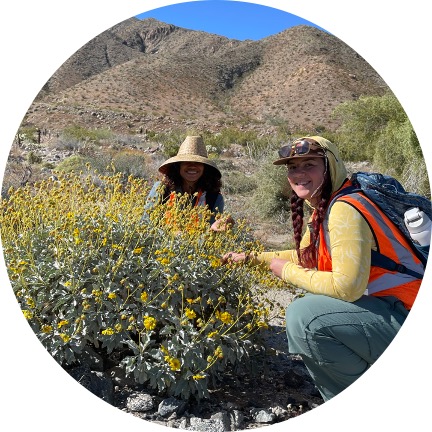
What we study

Data-driven invasive plant management
Managing invasive plant infestations is a major challenge, especially with limited resources. While controlled trials aimed at identifying effective control techniques are essential, these experiments do not reflect the real-world challenges of weed management programs. In collaboration with the National Park Service in the Santa Monica Mountains, we are analyzing decades of treatment and monitoring data to support the advancement of adaptive management strategies. We hope to expand this effort to more parks and natural areas throughout the state.

Climate-smart grassland restoration
California's grasslands harbor high plant diversity and provide critical ecosystem services, yet, they are some of the most degraded plant communities in the State. Our lab researches multiple approaches to enhance restoration outcomes in invaded and disturbed grasslands, such as targeted mowing to control invasives and promote native bunchgrasses, optimizing seed mixes to increase resilience, and identifying the most appropriate ecotypes for restoration under increasing climate change.

Harnessing soil biota for ecological restoration
Beneficial soil biota, such as mycorrhizal fungi, play an important role in plant growth and stress tolerance, and they may also play a key role in enhancing ecological restoration in the Anthropocene. We are currently developing cheap and effective methods for augmenting native soil biota to be deployed as inoculum for grassland and desert restoration projects in California.

Prescribed fire and post-fire recovery
Fire is an important force shaping California’s ecosystems. While some species depend on fire, changing fire regimes pose a risk to many. We have several project exploring post-fire recovery and the use of prescribed fire in grasslands, shrublands, and forests. We also explore how invasion and environmental change may impact post-fire recovery. For example, we recently published a study showing that invasive species and nitrogen deposition suppress native fire-following plant species in coastal sage scrub.

Ecological impacts of nitrogen deposition
High levels of air pollution leads to elevated nitrogen deposition across large areas of California near urban areas. We investigate its effects on native plant communities, invasion, soil microbes, and interactions with drought. We also evaluate how we can restore ecosystems impacted by N deposition. Our research has shown that elevated N deposition can exacerbate native shrub mortality and invasion during extreme drought and severely impact native wildflower diversity.

Heat tolerance in the California flora
As part of California's Fifth Climate Change Assessment we are currently exploring heat tolerance of native plant species across California’s diverse ecosystems to identify vulnerable populations and inform conservation and restoration under climate change. Our previous research showed that certain leaf traits are strong predictors of heat tolerance in coastal sage scrub and chaparral species.

Restoration training & education
Training and inspiring the next generation of practitioners is essential for meeting the growing need for restoration projects worldwide. In addition to studying the science and practice of restoration, we aim to develop fun and effective training opportunities for all ages. For example, we have developed training programs for students of all ages to participate in grassland restoration. We have also designed and evaluated the outcomes of undergraduate projects aimed at providing first-hand experience in restoration and applied urban ecology research.

Restoration ecophysiology
Methods for measuring plant physiological function provide valuable insights into the performance of restored plant communities. By integrating restoration ecophysiology, practitioners can make informed decisions on species selection, site preparation, and strategies to enhance plant establishment. Monitoring key physiological traits, particularly those related to water use, can also serve as an early indicator of restoration success or failure, guiding adaptive management approaches. We successfully leveraged this ecophysiological approach to guide mine site restoration in Western Australia, and these methods can be applied more broadly to conservation and restoration strategies across taxa and ecosystems.
